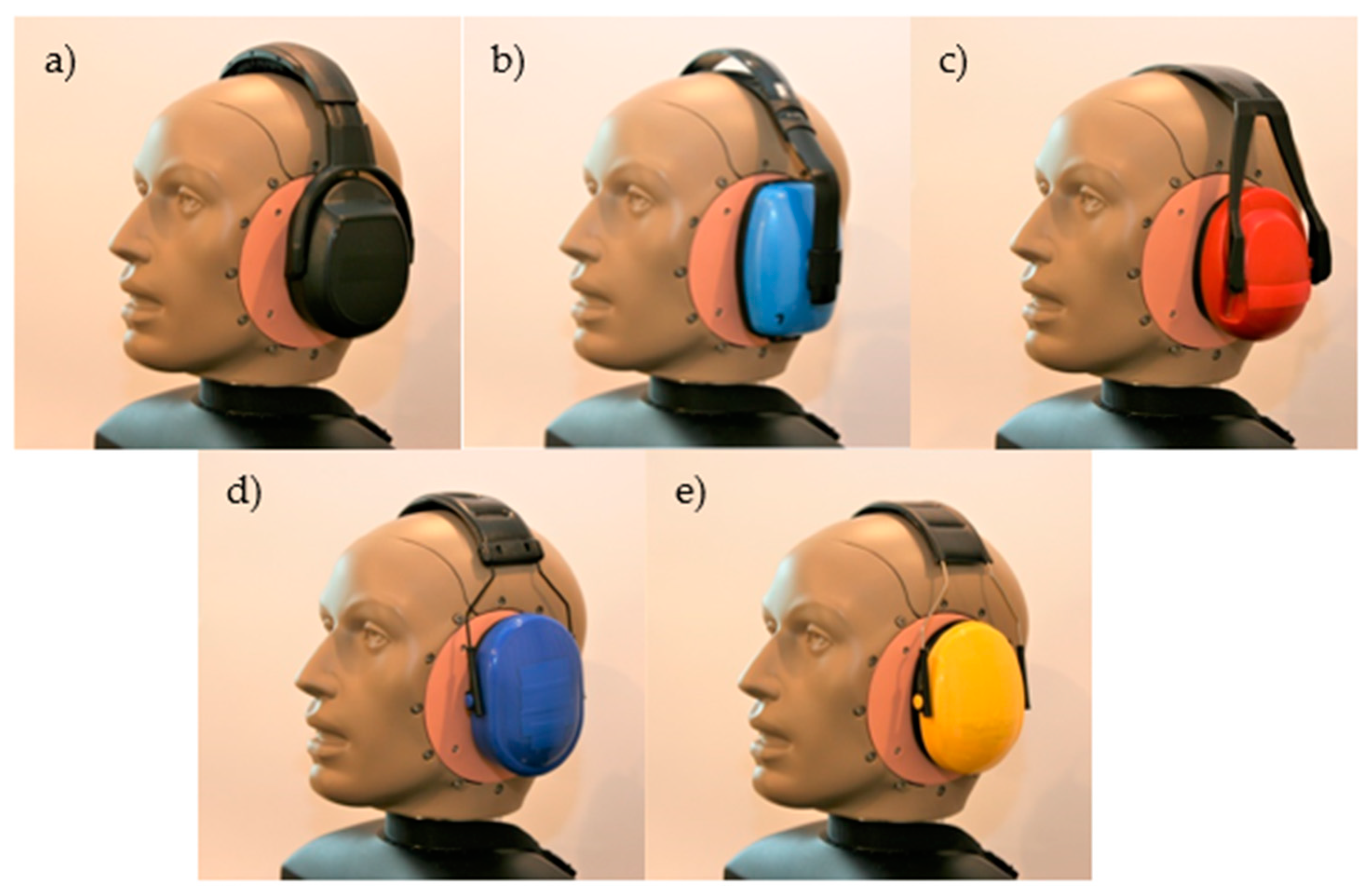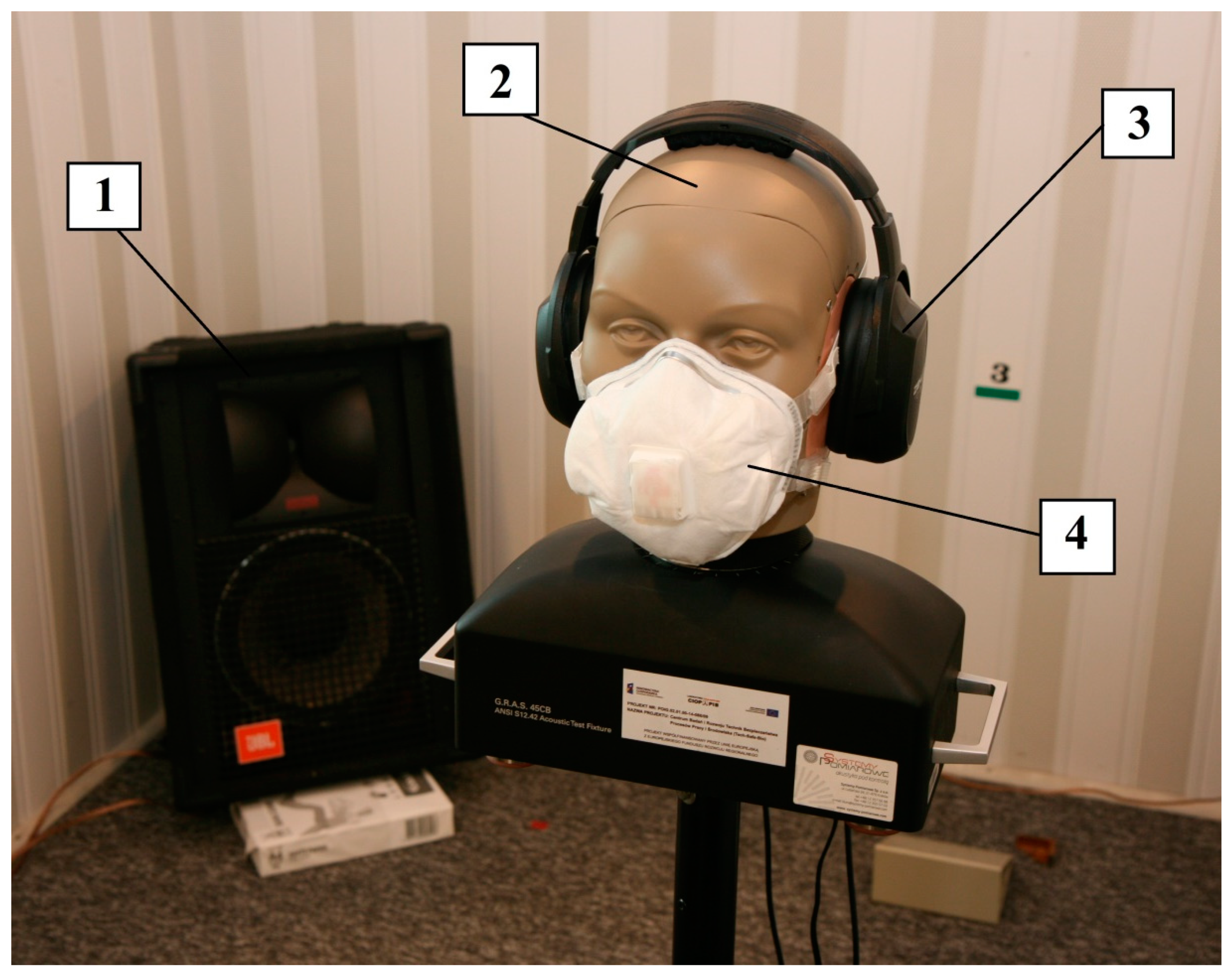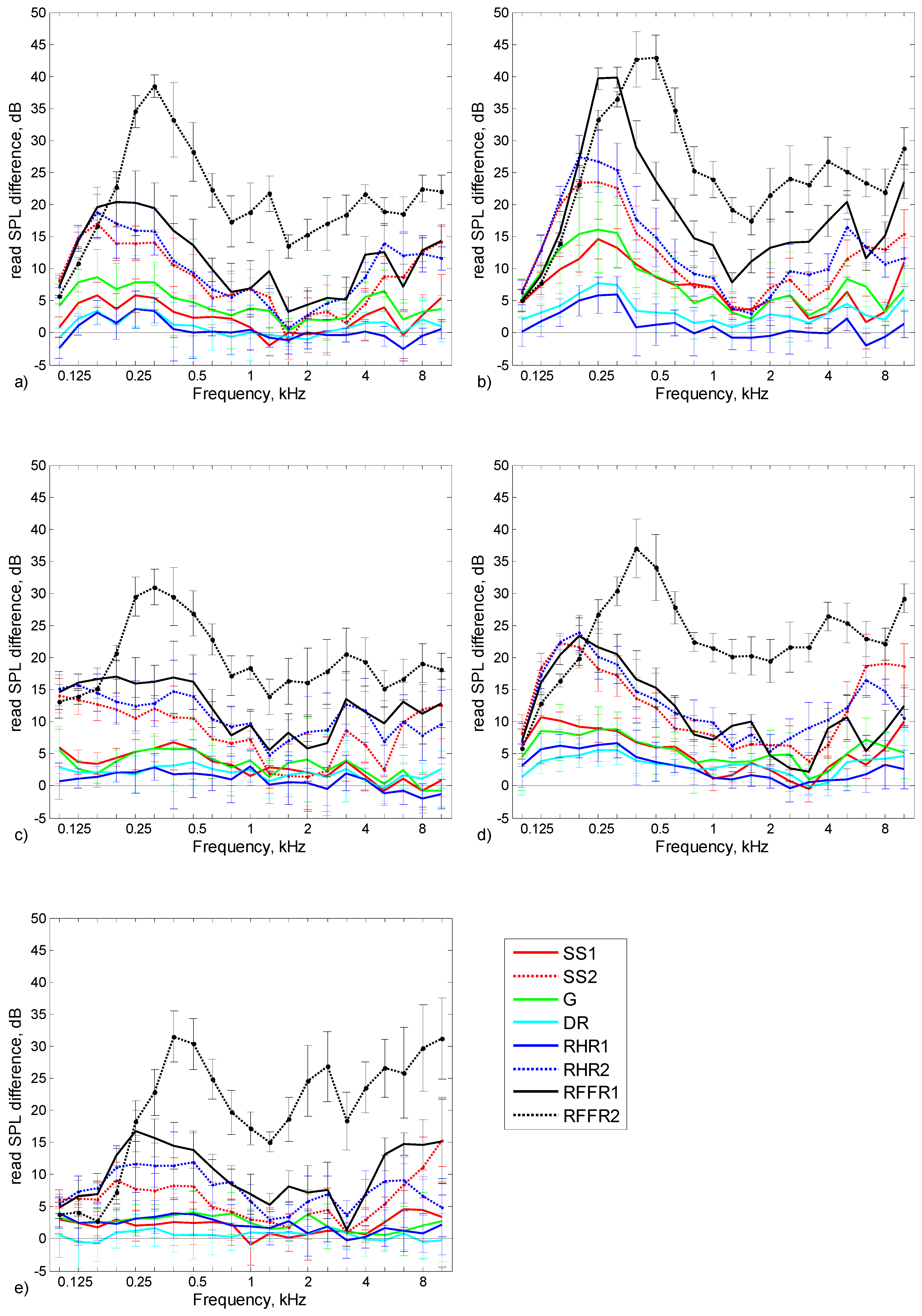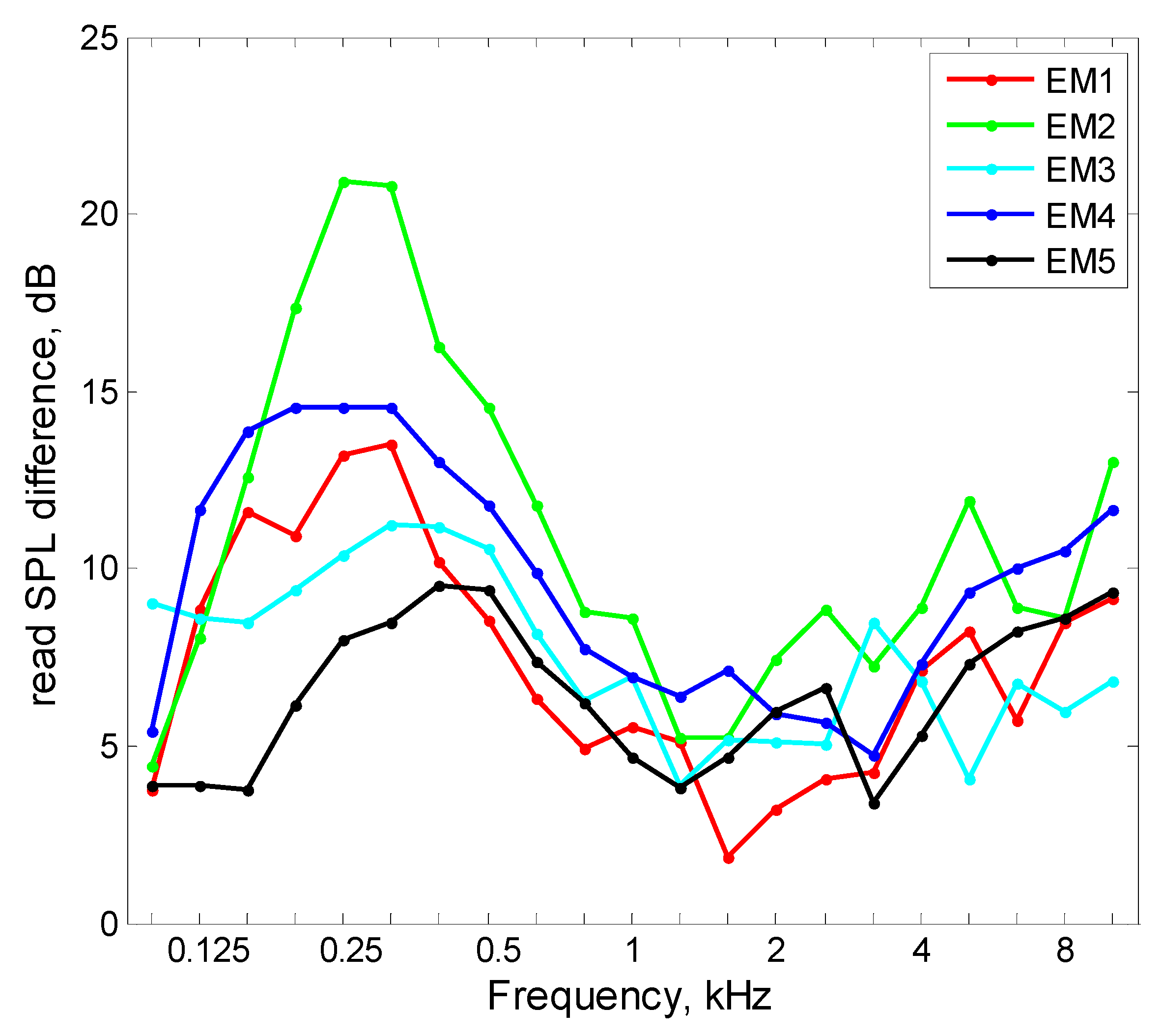Selection of Earmuffs and Other Personal Protective Equipment Used in Combination
Abstract
1. Introduction
2. Materials and Methods
2.1. Earmuffs
2.2. Other Personal Protective Equipment
2.3. Measuring Setup
2.4. Statistical Analysis
3. Results
4. Discussion
5. Conclusions
Author Contributions
Funding
Conflicts of Interest
References
- CEN. EN 458:2016 Hearing Protectors—Recommendations for Selection, Use, Care and Maintenance—Guidance Document; European Committee for Standardization: Brussels, Belgium, 2016. [Google Scholar]
- Azares, P.M.; Miguel, A.S. Assessing the use of hearing protection in industrial settings: A comparison between methods. Int. J. Ind. Ergon. 2013, 43, 518–525. [Google Scholar] [CrossRef]
- Berger, E.H. Methods of measuring the attenuation of hearing protection devices. J. Acoust. Soc. Am. 1986, 79, 1655–1687. [Google Scholar] [CrossRef] [PubMed]
- Biabani, A.; Aliabadi, M.; Golmohammadi, R.; Farhadian, M. Individual fit testing of hearing protection devices based on microphone in Real Ear. Saf. Health Work 2017, 8, 364–370. [Google Scholar] [CrossRef] [PubMed]
- Casali, J.G.; Park, M.Y. Laboratory versus field attenuation of selected hearing protectors. Sound Vib. 1991, 25, 28–38. [Google Scholar]
- Giardino, D.A.; Durkt, G. Evaluation of muff-type hearing protectors as used in a working environment. Am. Ind. Hyg. Assoc. J. 1996, 57, 264–271. [Google Scholar] [CrossRef] [PubMed]
- Kotarbinska, E.; Kozlowski, E. Measurement of effective noise exposure of workers wearing ear-muffs. Int. J. Occup. Saf. Ergon. 2009, 15, 193–200. [Google Scholar] [CrossRef] [PubMed][Green Version]
- Kusy, A.; Châtillon, J. Real-world attenuation of custom-moulded earplugs: Results from industrial in situ F-MIRE measurements. Appl. Acoust. 2012, 73, 639–647. [Google Scholar] [CrossRef][Green Version]
- Neitzel, R.; Seixas, N. The Effectiveness of Hearing Protection among Construction Workers. J. Occup. Environ. Hyg. 2005, 2, 227–238. [Google Scholar] [CrossRef] [PubMed]
- Rocha, C.H.; Longo, I.A.; Moreira, R.R.; Samelli, A.G. Evaluation of the hearing protector in a real work situation using the field-microphone-in-real-ear method. CODAS 2016, 28, 99–105. [Google Scholar] [CrossRef] [PubMed]
- ISO. ISO 4869-1:2018. Acoustics—Hearing Protectors—Part 1: Subjective Method for the Measurement of Sound Attenuation; International Organization for Standardization: Geneva, Switzerland, 2018. [Google Scholar]
- ANSI. ANSI S3.19-1974, American National Standard Method for the Measurement of Real-Ear Protection of Hearing Protectors and Physical Attenuation of Earmuffs; American National Standards Institute: New York, NY, USA, 1974. [Google Scholar]
- ASA. ANSI/ASA S12.6-2016. Methods for Measuring the Real Ear Attenuation of Hearing Protectors; Acoustical Society of America: New York, NY, USA, 2016. [Google Scholar]
- Liedtke, M. Risk by use of hearing protectors—Expert programme supports SMEs in appropriate selection and use. Noise Health 2005, 7, 31–37. [Google Scholar] [CrossRef] [PubMed]
- Nélisse, H.; Gaudreau, M.A.; Boutin, J.; Voix, J.; Laville, F. Measurement of hearing protection devices performance in the workplace during full-shift working operations. Ann. Occup. Hyg. 2012, 56, 221–232. [Google Scholar] [CrossRef] [PubMed][Green Version]
- Kotarbinska, E. The influence of aging on the noise attenuation of ear-muffs. Noise Health 2005, 7, 39–45. [Google Scholar] [CrossRef] [PubMed]
- Rawlinson, R.D.; Wheeler, P.D. The effects of industrial use on the acoustical performance of some earmuffs. Ann. Occup. Hyg. 1987, 31, 291–298. [Google Scholar] [CrossRef] [PubMed]
- Carletti, E.; Pedrielli, F. The ageing effect on the acoustic performance of earmuffs: An investigation involving the forestry compartment. In Proceedings of the 10th International Congress on Sound and Vibration, Stockholm, Sweden, 7–10 July 2003. [Google Scholar]
- Abel, S.M.; Sass-Kortsak, A.; Kielar, A. The effect on earmuff attenuation of other safety gear worn in combination. Noise Health 2002, 5, 1–13. [Google Scholar]
- Chung, D.Y.; Hardie, R.; Gannon, R.P. The effect of hair, glasses, or cap on the performance of one pair of Bilsom Viking circumaural hearing protectors. Can. Acoust. 1983, 11, 45–49. [Google Scholar]
- Lemstad, F.; Kluge, R. Real-world attenuation of muff-type hearing protectors: The effect of spectacles. In Proceedings of the Joint Baltic-Nordic Acoustics Meeting, Mariehamn, Åland, Finland, 8–10 June 2004. [Google Scholar]
- Wells, L.; Berger, E.H.; Keiper, R. Attenuation characteristics of fit-compromised earmuffs and various nonstandard hearing protectors. Proc. Meet. Acoust. 2013, 19. [Google Scholar] [CrossRef]
- ASA. ANSI/ASA S12.42-2010. Methods for the Measurement of Insertion Loss of Hearing Protection Devices in Continuous or Impulsive Noise Using Microphone-in-Real-Ear or Acoustic Test Fixture Procedures; Acoustical Society of America: New York, NY, USA, 2010. [Google Scholar]
- Mlynski, R.; Kozlowski, E. Noise reduction at the shooting range by means of level-dependent hearing protectors. Med. Pr. 2018, 70. [Google Scholar] [CrossRef]
- Nakashima, A. Comparison of different types of hearing protection devices for use during weapons firing. J. Mil. Veteran Fam. Health 2015, 1, 43–51. [Google Scholar] [CrossRef]
- Mlynski, R.; Kozlowski, E. Impulse noise attenuation when earmuffs are worn with safety spectacles. In Proceedings of the 22th International Congress on Sound and Vibration, Florence, Italy, 12–16 July 2015. [Google Scholar]
- Kozlowski, E.; Mlynski, R. Attenuation of earmuffs used simultaneously with respiratory protective devices. Med. Pr. 2017, 68, 349–361. [Google Scholar] [CrossRef] [PubMed]





| Earmuffs | OPPE | ||||||||
|---|---|---|---|---|---|---|---|---|---|
| Without | SS1 | SS2 | G | DR | RHR1 | RHR2 | RFFR1 | RFFR2 | |
| EM1 | 71.1 | 72.5 | 78.8 | 74.6 | 71.4 | 71.1 | 80.2 | 81.5 | 94.2 |
| EM2 | 71.1 | 77.0 | 82.6 | 78 | 74.4 | 71.9 | 83.8 | 91.2 | 97.9 |
| EM3 | 69.2 | 72.1 | 76.9 | 72.6 | 71 | 69.6 | 79.7 | 80.8 | 90.7 |
| EM4 | 69.8 | 74.5 | 83.2 | 75.1 | 72.6 | 72.1 | 82.9 | 82.1 | 94.8 |
| EM5 | 73.7 | 75.5 | 79.5 | 76.1 | 74.3 | 75.9 | 81.9 | 84.4 | 95.3 |
| Earmuffs | p-Value | |||||||
|---|---|---|---|---|---|---|---|---|
| Without SS1 | Without SS2 | Without G | Without DR | Without RHR1 | Without RHR2 | Without RFFR1 | Without RFFR2 | |
| EM1 | 0.42 | 0.03 | 0.15 | 0.86 | 1 | <0.01 | <0.01 | <0.01 |
| EM2 | <0.01 | <0.01 | <0.01 | 0.07 | 0.71 | <0.01 | <0.01 | <0.01 |
| EM3 | 0.37 | 0.02 | 0.33 | 0.41 | 0.74 | <0.01 | <0.01 | <0.01 |
| EM4 | 0.14 | <0.01 | 0.07 | 0.26 | 0.35 | <0.01 | <0.01 | <0.01 |
| EM5 | 0.41 | 0.11 | 0.41 | 0.84 | 0.51 | 0.03 | 0.01 | <0.01 |
© 2019 by the authors. Licensee MDPI, Basel, Switzerland. This article is an open access article distributed under the terms and conditions of the Creative Commons Attribution (CC BY) license (http://creativecommons.org/licenses/by/4.0/).
Share and Cite
Kozlowski, E.; Mlynski, R. Selection of Earmuffs and Other Personal Protective Equipment Used in Combination. Int. J. Environ. Res. Public Health 2019, 16, 1477. https://doi.org/10.3390/ijerph16091477
Kozlowski E, Mlynski R. Selection of Earmuffs and Other Personal Protective Equipment Used in Combination. International Journal of Environmental Research and Public Health. 2019; 16(9):1477. https://doi.org/10.3390/ijerph16091477
Chicago/Turabian StyleKozlowski, Emil, and Rafal Mlynski. 2019. "Selection of Earmuffs and Other Personal Protective Equipment Used in Combination" International Journal of Environmental Research and Public Health 16, no. 9: 1477. https://doi.org/10.3390/ijerph16091477
APA StyleKozlowski, E., & Mlynski, R. (2019). Selection of Earmuffs and Other Personal Protective Equipment Used in Combination. International Journal of Environmental Research and Public Health, 16(9), 1477. https://doi.org/10.3390/ijerph16091477





